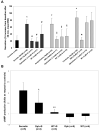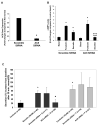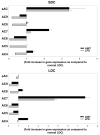Differentially expressed adenylyl cyclase isoforms mediate secretory functions in cholangiocyte subpopulation
- PMID: 19444869
- PMCID: PMC2738985
- DOI: 10.1002/hep.22926
Differentially expressed adenylyl cyclase isoforms mediate secretory functions in cholangiocyte subpopulation
Abstract
Cyclic adenosine monophosphate (cAMP) is generated by adenylyl cyclases (ACs), a group of enzymes with different tissue specificity and regulation. We hypothesized that AC isoforms are heterogeneously expressed along the biliary tree, are associated with specific secretory stimuli, and are differentially modulated in cholestasis. Small duct and large duct cholangiocytes were isolated from controls and from lipopolysaccharide-treated or alpha-naphthylisothiocyanate-treated rats. AC isoform expression was assessed via real-time polymerase chain reaction. Secretion and cAMP levels were measured in intrahepatic bile duct units after stimulation with secretin, forskolin, HCO(3)(-)/CO(2), cholinergic agonists, and beta-adrenergic agonists, with or without selected inhibitors or after silencing of AC8 or soluble adenylyl cyclase (sAC) with small interfering RNA. Gene expression of the Ca(2+)-insensitive isoforms (AC4, AC7) was higher in small duct cholangiocytes, whereas that of the Ca(2+)-inhibitable (AC5, AC6, AC9), the Ca(2+)/calmodulin-stimulated AC8, and the soluble sAC was higher in large duct cholangiocytes. Ca(2+)/calmodulin inhibitors and AC8 gene silencing inhibited choleresis and cAMP production stimulated by secretin and acetylcholine, but not by forskolin. Secretion stimulated by isoproterenol and calcineurin inibitors was cAMP-dependent and gamma-aminobutyric acid-inhibitable, consistent with activation of AC9. Cholangiocyte secretion stimulated by isohydric changes in [HCO(3)(-)](i) was cAMP-dependent and inhibited by sAC inhibitor and sAC gene silencing. Treatment with lipopolysaccharide or alpha-naphthylisothiocyanate increased expression of AC7 and sAC but decreased expression of the other ACs.
Conclusion: These studies demonstrate a previously unrecognized role of ACs in biliary pathophysiology. In fact: (1) AC isoforms are differentially expressed in cholangiocyte subpopulations; (2) AC8, AC9, and sAC mediate cholangiocyte secretion in response to secretin, beta-adrenergic agonists, or changes in [HCO(3)(-)](i), respectively; and (3) AC gene expression is modulated in experimental cholestasis.
Figures






Similar articles
-
After damage of large bile ducts by gamma-aminobutyric acid, small ducts replenish the biliary tree by amplification of calcium-dependent signaling and de novo acquisition of large cholangiocyte phenotypes.Am J Pathol. 2010 Apr;176(4):1790-800. doi: 10.2353/ajpath.2010.090677. Epub 2010 Feb 25. Am J Pathol. 2010. PMID: 20185575 Free PMC article.
-
Alpha-1 adrenergic receptor agonists modulate ductal secretion of BDL rats via Ca(2+)- and PKC-dependent stimulation of cAMP.Hepatology. 2004 Nov;40(5):1116-27. doi: 10.1002/hep.20424. Hepatology. 2004. Retraction in: Hepatology. 2025 Jul 1;82(1):E21. doi: 10.1097/HEP.0000000000001382. PMID: 15486932 Retracted.
-
Adenylyl cyclase 6 mediates the action of cyclic AMP-dependent secretagogues in mouse pancreatic exocrine cells via protein kinase A pathway activation.J Physiol. 2013 Aug 1;591(15):3693-707. doi: 10.1113/jphysiol.2012.249698. Epub 2013 Jun 10. J Physiol. 2013. PMID: 23753526 Free PMC article.
-
Transport systems in cholangiocytes: their role in bile formation and cholestasis.Yale J Biol Med. 1997 Jul-Aug;70(4):427-34. Yale J Biol Med. 1997. PMID: 9626763 Free PMC article. Review.
-
New insights concerning the molecular basis for defective glucoregulation in soluble adenylyl cyclase knockout mice.Biochim Biophys Acta. 2014 Dec;1842(12 Pt B):2593-600. doi: 10.1016/j.bbadis.2014.06.023. Epub 2014 Jun 27. Biochim Biophys Acta. 2014. PMID: 24980705 Free PMC article. Review.
Cited by
-
International Union of Basic and Clinical Pharmacology. CI. Structures and Small Molecule Modulators of Mammalian Adenylyl Cyclases.Pharmacol Rev. 2017 Apr;69(2):93-139. doi: 10.1124/pr.116.013078. Pharmacol Rev. 2017. PMID: 28255005 Free PMC article. Review.
-
Coordinate down-regulation of adenylyl cyclase isoforms and the stimulatory G protein (G(s)) in intestinal epithelial cell differentiation.J Biol Chem. 2010 Apr 23;285(17):12504-11. doi: 10.1074/jbc.M109.059741. Epub 2010 Feb 15. J Biol Chem. 2010. PMID: 20157112 Free PMC article.
-
Activation of alpha(1) -adrenergic receptors stimulate the growth of small mouse cholangiocytes via calcium-dependent activation of nuclear factor of activated T cells 2 and specificity protein 1.Hepatology. 2011 Feb;53(2):628-39. doi: 10.1002/hep.24041. Epub 2011 Jan 3. Hepatology. 2011. PMID: 21274883 Free PMC article.
-
Histamine stimulates the proliferation of small and large cholangiocytes by activation of both IP3/Ca2+ and cAMP-dependent signaling mechanisms.Lab Invest. 2012 Feb;92(2):282-94. doi: 10.1038/labinvest.2011.158. Epub 2011 Nov 7. Lab Invest. 2012. PMID: 22064319 Free PMC article.
-
Regulators of Cholangiocyte Proliferation.Gene Expr. 2017 Feb 10;17(2):155-171. doi: 10.3727/105221616X692568. Epub 2016 Jul 12. Gene Expr. 2017. PMID: 27412505 Free PMC article. Review.
References
-
- Strazzabosco M, Fabris L, Spirli C. Pathophysiology of cholangiopathies. J Clin Gastroenterol. 2005;39:S90–S102. - PubMed
-
- Lazaridis KN, Strazzabosco M, Larusso NF. The cholangiopathies: disorders of biliary epithelia. Gastroenterology. 2004;127:1565–1577. - PubMed
-
- Alpini G, Glaser S, Robertson W, Rodgers RE, Phinizy JL, Lasater J, et al. Large but not small intrahepatic bile ducts are involved in secretin-regulated ductal bile secretion. Am J Physiol Gastrointest Liver Physiol. 1997;272:G1064–1074. - PubMed
-
- Alpini G, Roberts S, Kuntz SM, Ueno Y, Gubba S, Podila PV, et al. Morphological, molecular, and functional heterogeneity of cholangiocytes from normal rat liver. Gastroenterology. 1996;110:1636–1643. - PubMed
Publication types
MeSH terms
Substances
Grants and funding
LinkOut - more resources
Full Text Sources
Other Literature Sources
Molecular Biology Databases
Miscellaneous
